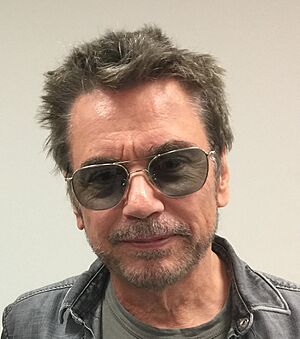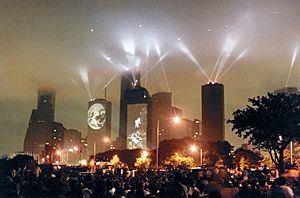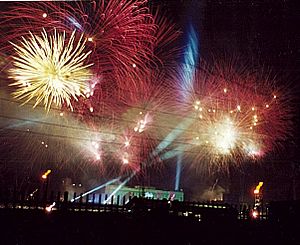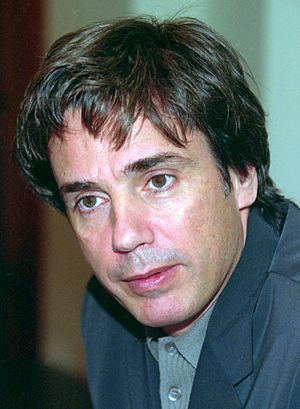Jean-Michel Jarre facts for kids
Quick facts for kids
Jean-Michel Jarre
|
|
|---|---|

Jarre in 2017
|
|
| Background information | |
| Birth name | Jean-Michel André Jarre |
| Born | 24 August 1948 Lyon, France |
| Genres |
|
| Occupations |
|
| Instruments | |
| Years active | 1960–present |
| Labels | |
| Associated acts | Gorillaz |
| Parent(s) |
|
| Signature | |
 |
|
Jean-Michel André Jarre (born August 24, 1948) is a French composer and musician. He is a pioneer of electronic music, ambient music, and new-age music. Jarre is famous for his huge outdoor concerts. These shows feature his music along with amazing laser light shows, giant projections on buildings, and fireworks.
Jarre grew up in Lyon, France, where he learned to play the piano. He was inspired by many types of art, from street performers to jazz musicians. A big influence on him was Pierre Schaeffer, who created a style of music called musique concrète. This style uses recorded sounds as musical instruments.
His first major success was the 1976 album Oxygène. He recorded it in a small studio he built in his home. The album sold around 18 million copies worldwide. In 1979, he held a concert in Paris that was attended by over a million people. This set a world record that he would break three more times. Many of his albums were created for these large-scale events. He has sold an estimated 80 million albums and singles.
Contents
Early Life and Musical Beginnings
Jean-Michel Jarre was born in Lyon, France, on August 24, 1948. His mother, Francette Pejot, was a member of the French Resistance during World War II. His father was the famous film score composer Maurice Jarre. When Jarre was five, his parents separated. His father moved to the United States, and Jarre was raised by his mother and grandparents.
Jarre's grandfather was an inventor and oboe player who gave him his first tape recorder. Jarre became interested in music after visiting a Paris jazz club with his mother. He realized that music could be "descriptive, without lyrics." He was also inspired by art, especially the paintings of Pierre Soulages. He said that art taught him that you could "act as a painter with frequencies and sounds."
As a young man, Jarre played guitar in a band called The Dustbins. In 1969, he joined the Groupe de Recherches Musicales (GRM), a group focused on experimental music. There, he learned about musique concrète and the Moog synthesizer. This experience was very important for his future career. He set up a small recording studio in his kitchen using early synthesizers and tape machines.
Rise to Fame in the 1970s
In the early 1970s, Jarre composed music for ballets, TV shows, and even commercials. He released his first solo album, Deserted Palace, in 1972. He also wrote the soundtrack for the film Les Granges Brûlées (The Burned Barns).
Oxygène and Équinoxe
Jarre's big break came in 1976 with his album Oxygène. He recorded it in his home studio on a small budget. At first, record companies rejected it. But he finally found a label, and the album became a huge international hit. It was promoted in hi-fi shops and clubs, and its unique electronic sound captured people's attention.
In 1978, he released his next album, Équinoxe. It was also successful and continued his signature electronic style.
Record-Breaking Concert
On July 14, 1979 (France's Bastille Day), Jarre held a massive free concert at the Place de la Concorde in Paris. Over one million people attended, setting a new world record for the largest concert audience. The show used light projections and fireworks, creating a model for his future performances. The concert's success caused a huge jump in his album sales.
Global Success in the 1980s
Jarre's 1981 album, Les Chants Magnétiques, used a new instrument called the Fairlight CMI. This digital synthesizer allowed him to experiment with sound in new ways.
Concerts in China
In 1981, Jarre became the first Western musician to be invited to perform in the People's Republic of China. He held five concerts in Beijing and Shanghai. The shows were a major cultural event in China. Recordings from these concerts were released as a live album, Les Concerts en Chine. The shows also featured one of his most famous instruments, the laser harp, which creates sound when its laser beams are touched.
Rendez-vous Houston
In 1986, Jarre performed a spectacular concert in Houston, Texas, to celebrate the state's 150th anniversary and NASA's 25th anniversary. The city's skyscrapers were used as giant screens for projections of light and images.
Astronaut Ronald McNair, a talented saxophone player, was supposed to play a solo from space during the concert. Tragically, McNair died in the Space Shuttle Challenger disaster just a few months before the show. The concert went on in memory of the crew. McNair's part was played on Earth by saxophonist Kirk Whalum and the song was renamed "Ron's Piece." The concert, called Rendez-vous Houston, was attended by 1.5 million people, breaking Jarre's own world record.
Destination Docklands in London
In 1988, Jarre planned a concert called Destination Docklands in London. The show faced many challenges, including bad weather. The stage was built on a floating platform in the Royal Victoria Dock. Despite high winds and rain, two shows were held for an audience of 200,000 people.
The 1990s: Decade of Mega-Concerts
In 1990, Jarre released En Attendant Cousteau (Waiting for Cousteau), an album dedicated to the ocean explorer Jacques-Yves Cousteau. That same year, he broke his audience record again. He performed for 2.5 million people at La Défense in Paris.
In 1993, he released the album Chronologie. It mixed the sounds of his classic 1970s synthesizers with the dance beats of the 1990s. He followed this with the Europe in Concert tour, performing in cities like London, Barcelona, and Versailles.
In 1995, he performed the Concert for Tolerance in Paris to celebrate the 50th anniversary of the United Nations. The Eiffel Tower was specially lit for the event.
Oxygène's Sequel and Moscow Concert
In 1997, Jarre released Oxygène 7–13, a sequel to his most famous album. He dedicated it to his mentor, Pierre Schaeffer.
In September 1997, he set his fourth world record for the largest concert audience. He performed in Moscow to celebrate the city's 850th anniversary. An estimated 3.5 million people attended the show.
Music and Technology in the 2000s
At the end of 1999, Jarre performed a concert called The Twelve Dreams of the Sun at the pyramids in Giza, Egypt, to celebrate the new millennium.
In 2004, he returned to China for two more concerts. One was held at the Forbidden City and the other in Tiananmen Square. That same year, he released AERO, a collection of his famous tracks re-recorded in 5.1 surround sound.
In 2007, he released Oxygène: New Master Recording, a new version of his classic album. He performed the album live in a series of concerts in Paris and across Europe.
Collaborations and Recent Work (2010s-Present)
In the 2010s, Jarre began working with many other artists.
Electronica Project
In 2015 and 2016, he released two albums, Electronica 1: The Time Machine and Electronica 2: The Heart of Noise. These albums featured collaborations with artists like M83, Tangerine Dream, Pet Shop Boys, and Hans Zimmer. One track even included speech from Edward Snowden. The Electronica project was nominated for a Grammy Award.
Virtual Reality and Recent Albums
Jarre has continued to explore new technology. On New Year's Eve 2020, he performed a virtual concert inside a digital recreation of the Notre Dame cathedral. The online show was watched by over 75 million people.
His 2022 album, Oxymore, was a tribute to the composer Pierre Henry. It was created as an immersive experience that could be listened to in 3D audio and in virtual reality (VR).
On December 25, 2023, Jarre performed a special concert in the Hall of Mirrors at the Palace of Versailles to celebrate its 400th anniversary.
Personal Life
Jean-Michel Jarre has been married four times. His first marriage was to Flore Guillard from 1975 to 1977. He was then married to British actress Charlotte Rampling from 1978 to 2002. They have a son named David.
He later married French actress Anne Parillaud in 2005, and they separated in 2010. In 2019, he married Chinese actress Gong Li.
Jarre did not have a close relationship with his father, composer Maurice Jarre, who lived in the United States for most of Jean-Michel's life. He has said that the feeling of his father's absence was difficult for him.
Major Concerts
| Date | Audience | Place | Event | Note |
|---|---|---|---|---|
| 14 July 1979 | 1 million | Place de la Concorde | celebrating Bastille Day | 1st entry in the Guinness Book of Records for largest outdoor concert crowd. |
| 5 April 1986 | 1.5 million | Houston | celebration of the 150th anniversary of Texas and 25th anniversary of NASA | 2nd entry in the Guinness Book of Records. |
| 5 October 1986 | 0.8 million | Lyon | To celebrate Pope John Paul II's visit to Jarre's hometown of Lyon. | |
| 8, 9 October 1988 | 0.2 million | London | Large outdoor concert titled "Destination Docklands" performed in London's docklands. | Noted for its planning difficulties and poor weather. |
| 14 July 1990 | 2.5 million | Paris la Défense | celebration of the 200th anniversary of the French Revolution 1789–1989 | 3rd entry in the Guinness Book of Records. |
| 14 July 1995 | 1.25 million | Eiffel Tower | UNESCO's 50th birthday and UNESCO'S proclaimed year of tolerance | |
| 6 September 1997 | 3.5 million | Moscow | Jarre was invited for a concert celebrating the 850th birthday of Moscow | 4th entry in the Guinness Book of Records. |
| 31 December 1999 | 0.1 million | Giza Plateau | New Millennium | "The Twelve Dreams of the Sun", celebrating the 7th millennium of Egypt. |
Discography
- 1973 – Deserted Palace
- 1973 – Les Granges Brûlées
- 1976 – Oxygène
- 1978 – Équinoxe
- 1981 – Les Chants Magnétiques
- 1982 – Les Concerts en Chine
- 1983 – Musique pour Supermarché
- 1984 – Zoolook
- 1986 – Rendez-Vous
- 1988 – Revolutions
- 1990 – En attendant Cousteau
- 1993 – Chronologie
- 1997 – Oxygène 7–13
- 2000 – Métamorphoses
- 2001 – Interior Music
- 2002 – Sessions 2000
- 2003 – Geometry of Love
- 2007 – Téo & Téa
- 2007 – Oxygène: New Master Recording
- 2015 – Electronica 1: The Time Machine
- 2016 – Electronica 2: The Heart of Noise
- 2016 – Oxygène 3
- 2018 – Equinoxe Infinity
- 2021 – Amazônia
- 2022 – Oxymore
- 2023 – Oxymoreworks
Images for kids
See also
 In Spanish: Jean-Michel Jarre para niños
In Spanish: Jean-Michel Jarre para niños
- List of ambient music artists
- List of Jean-Michel Jarre compositions with multiple titles
- List of Jean-Michel Jarre concerts









